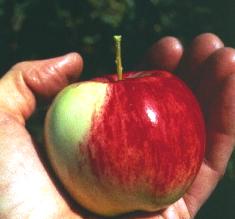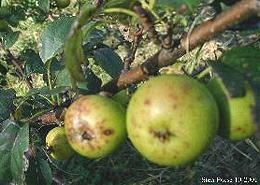
Roses

Magnolias
The cultivated apple originated in Central Asia, around Kazakhstan, where it's wild ancestor (Malus sylvestris) can still be found today. China grows 35% of world production and the US, where apples were introduced by European colonists, is second with 7.5%
There are over 7500 known varieties of apple, the ones listed here are ones commonly available in Southern California. Nearly all are grown in the Pacific Northwest, particularly Washington state, where the weather gets cold enough to set fruit properly.
|
Braeburn - [PLU 4103 (large) 4101 (small)]
Cameo - [PLU 3066 (large 3065 (small))]
Crab Apple - (commercial)
Fuji - [PLU 4131 (large)]
Granny Smith - [PLU 4017 (large)]
Jonagold - [PLU 4145 (small)]
Lady Apple
Red Delicious [PLU 4015 (small)]
At best they are crisp and juicy, moderately sweet, but
have little flavor. At worst they are dry, pasty and flavorless. They
also don't cook well. They are subject to freeze damage when the flesh
will be discolored and slightly translucent. The photo specimens were
typically 2.9 inches diameter and weighed 6-5/8 ounces - this is the
"small" size. Large ones run about 3-1/4 inches diameter and weight
about 10 ounces.
|
Crab Apples
[American Crabapples: Malus ioensis (Prairie
crabapple); Malus fusca (Pacific /
Oregon crabapple); Malus coronaria (Sweet crabapple);
Malus angustifolia (Southern crabapple)]
[Other Crabapples:
Malus floribunda (Japanese crabapple); Malus florentina
(Florentine / Balkan crabapple); Malus baccata (Siberian crabapple);
Malus prunifolia Plumpleafed / Chinese crabapple);
Malus spectabilis (Asiatic crabapple); Malus sikkimensis
(Sikkim crabapple); Malus tschonoskii]

Crabapples are much smaller than regular apples and may have long stems (as in the photo) or short stems. Most ripen red but some golden versions have been developed. Considering Omaha as the location, the photo specimens are probably M. ioensis, the most common variety of crabapple in North America.
Most crabapples are less than 1 inch diameter, ascidic and astringent -
too much so for general eating but they are made into jams and jellies.
Crabapples are widely planted as landscaping decoratives for showy flowers
in the spring and autumn color.
Photo of ripe crabapples in the Lauritzen Botanical Gardens,
Omaha by John Severns distributed under license
Creative Commons
Attribution 2.5 Generic.
Health and Nutrition
Apples contain less vitamin C, antioxidants and fiber than many other fruits but are still a significant source, particularly since it's easy to eat a bunch of them. They are, therefore, considered to help avoid certain cancers. Apple juice concentrate is being investigated as possible aid to maintaining cognitive performance during aging.
Apple seed contain some cyanide compounds but not enough to be considered dangerous to humans.
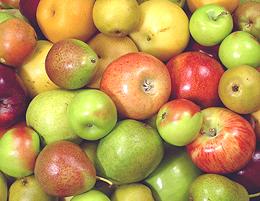 Apples
Apples
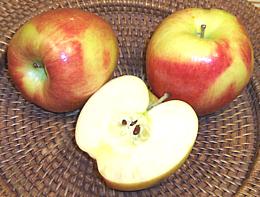 An excellent eating apple in my opinion, sweet/tart with good
flavor complexity. The photo specimens, "large braeburn", were typically
3-1/4 inch in diameter and weighed 10 ounces.
An excellent eating apple in my opinion, sweet/tart with good
flavor complexity. The photo specimens, "large braeburn", were typically
3-1/4 inch in diameter and weighed 10 ounces.
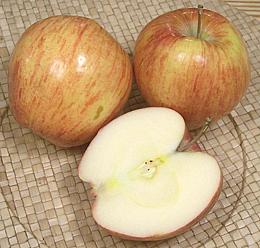 A crisp, medium sweet apple with good apple flavor and a very small
core. Excellent for salads. The photo specimens, "large cameo", were
typically 3-1/4 inches in diameter and weighed 9 ounces.
A crisp, medium sweet apple with good apple flavor and a very small
core. Excellent for salads. The photo specimens, "large cameo", were
typically 3-1/4 inches in diameter and weighed 9 ounces.
 These are not real crabapples, but that's the name apples under
2 inches diameter are marketed under. Real
These are not real crabapples, but that's the name apples under
2 inches diameter are marketed under. Real
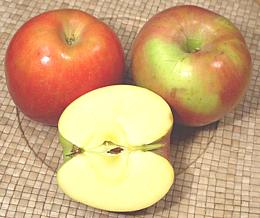 This Japanese style apple is now quite popular here in both "large" and
"small" sizes. It has silky, sweet flesh and light apple flavor. A
quite pleasant snack apple. It can be stored at room temperature or
(longer) refrigerated for longer periods than most other apple varieties.
The photo specimens were the "large" size, typically 3.9 inches diameter
and weighed 13-1/2 ounces.
This Japanese style apple is now quite popular here in both "large" and
"small" sizes. It has silky, sweet flesh and light apple flavor. A
quite pleasant snack apple. It can be stored at room temperature or
(longer) refrigerated for longer periods than most other apple varieties.
The photo specimens were the "large" size, typically 3.9 inches diameter
and weighed 13-1/2 ounces.
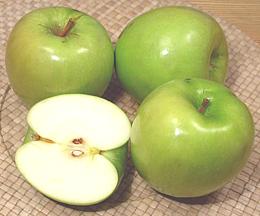 This is the standard cooking apple, firm and tart. It can be stored
at room temperature or (longer) refrigerated for longer periods than most
other apple varieties. The photo specimens were the "large" size,
typically 3.6 inches diameter and weighed 10-1/2 ounces. "Small" and
"lady" sizes are also available.
This is the standard cooking apple, firm and tart. It can be stored
at room temperature or (longer) refrigerated for longer periods than most
other apple varieties. The photo specimens were the "large" size,
typically 3.6 inches diameter and weighed 10-1/2 ounces. "Small" and
"lady" sizes are also available.
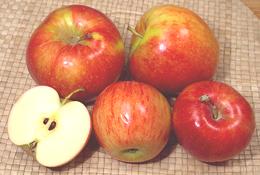 A good eating apple, almost crisp, sweet-tart with good apple flavor.
The photo specimens were the "large" size (back), typically 2.9 inches
diameter and weighed 11-1/8 ounces and "small" (front) 2.9 inches diameter
and weighed 5-3/4 ounces..
A good eating apple, almost crisp, sweet-tart with good apple flavor.
The photo specimens were the "large" size (back), typically 2.9 inches
diameter and weighed 11-1/8 ounces and "small" (front) 2.9 inches diameter
and weighed 5-3/4 ounces..
 Miniature versions of a number of apples now have the "lady" designation,
but this one seems to be the one sold without additional qualifiers, at
least around here. They are firm and tart, but not as tart as Granny
Smith (for which there is also a "lady" version).
The photo specimens were typically 2.1 inches diameter and weighed 2 ounces.
Miniature versions of a number of apples now have the "lady" designation,
but this one seems to be the one sold without additional qualifiers, at
least around here. They are firm and tart, but not as tart as Granny
Smith (for which there is also a "lady" version).
The photo specimens were typically 2.1 inches diameter and weighed 2 ounces.
 This was once the dominant apple available in stores - until growers in
the Pacific Northwest discovered that people actually wanted apples with
more apple flavor. These are easily recognizable by their perfect intense
red color and pointy shape.
This was once the dominant apple available in stores - until growers in
the Pacific Northwest discovered that people actually wanted apples with
more apple flavor. These are easily recognizable by their perfect intense
red color and pointy shape.